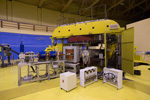
The basic directions of applied researches in HEPD - working out of methods of creation of carbon matrixes for long-term storage and a transmutation of long-living radio nuclides and the proton therapy
(protonnaya_terapiya)
at PNPI synchrocyclotron.
1. Working out of methods a long-living nuclear waste in carbon matrixes for their storage and a transmutation.
(See more... - russian version)
2.
Condition and prospect of development of nuclear medicine and hadronic therapy in PNPI.
(See more ... Abstract
and
Supplement - see russian version).
Since 1975, a Center of Ster
eotaxic Proton Therapy (CSPT)
is operating at Petersburg
Nuclear Physics Institute (PNPI) exploiting a
1000 MeV proton beam from the PNPI synchro-
cyclotron. The center is sp
ecialized on treatment of
some brain diseases, such as pituitary ade-
nomas and arteriovenous malformations. Small s
cattering of the 1000 MeV proton beam in the
tissue in combination with the irradiation rotation
technique provide high ratio of the radiation
doze in the irradiation zone to
that at the head surface. The f
unctioning of CSPT is performed
in close cooperation with the Russian Scientif
ic Center of Radiology
and Surgical Technology (RSCRST). At present, 1394 patients
have been treated in this cente
r. This method («Gatchinsky method») of high
energy proton therapy, being unique
in the world practice, is distinguished by high safety of the
irradiation process and high medica
l efficiency. However, its application is limited so far to
several brain diseases.
In addition to the existing CSPT center,
a project of the universal
center of proton therapy
with the proton beam energy variable in the
range 80-230 MeV is under
realization at PNPI-
RSCRST.
This center should provide th
e North-West region of Russi
a a possibility to treat a
wide spectrum of oncological diseases. The cent
er is created on the ba
sis of two proton accel
erators: a high current cyclotron C-80 (energy
80 MeV, current 100 mkA) and a fast cycling
proton synchrotron S-230 with variable energy
from 120 MeV to 230 MeV. The cyclotron C-80
is used as the injector
to the synchrotron S-230. In additi
on, a proton beam extracted from C-80
will be used for eyes therapy (high precision 80
MeV beam with low intensity), while the high
intensity (100 mkA) 80 MeV proton beam will
be used for production of radioisotopes for nu
clear medicine.
The proton synchrotron S-230 wa
s designed at G.N. Budker Nu
clear Physics Institute of
SB RAS. Its repetition rate is 1
Hz with a possibility for a 10
% modulation of the energy of the
extracted beam at the rate of 10 Hz. The irradiation stand will be e
quipped with the GANTRY
system. As the result, the four-dimension irradi
ation will be provided via variation of the beam
in X,Y,Z, and time, that, in particular, make
s possible synchronization of the beam stop posi
tion with the position of the organs m
oving in course of irradiation.
The cyclotron C-80 will provide
production of a variety of ra
dioisotopes for medical ap
plications. In particular, production of the
82Sr – 82Rb generators could allow to use the positron-
emission tomography (PET) in the medical centers
which has no special cyclotrons for produc-
tion of the PET emitters.
PNPI can also produce radioisotopes
in nuclear reactors. This line becomes especially
promising after startup of the
high flux reactor PIK at PNPI.
The plans include production of
super clean short-lived isotopes without “hot ch
emistry” using the on-li
ne mass separator which
selects the desired isotopes direct
ly from the target placed in the
neutron channel of the reactor.
At present, the North-West region ha
s already some experience
in production and applica
tion of the radioisotopes
in medical practice. In
particular, the isotopes
99Ìî and 125I, produced
at PNPI at the existing nuclear reactor WWR-M
, are supplied to the Radium Institute in
St. Petersburg for production
of various radiopharm prep
arations. Also, the isotope
18F is pro
duced at RSCRST for a PET operating in this center.
3. Nuclear Physics - Nuclear Medicine.

Recent decades have seen the introduction of intensive methods of nuclear physics and high technologies in the field directly related to the quality of human life and, in particular, with the development of entirely new branches of medicine. Using the fundamental achievements of nuclear science was the basis for the creation of an entirely new direction of modern medicine -
Nuclear Medicine
The uniqueness of nuclear medicine techniques is that they allow you to diagnose functional abnormalities of life of the very early stages of the disease when a person does not feel symptoms. This makes it easier to detect and treat a wide variety of diseases, substantial savings on treatment.
(See more... - russian version)